|
|
| |
|
007
MAGAZINE Collectors’ Guide to
James Bond UK PAN Paperbacks
WRITTEN &
COMPILED BY KEVIN HARPER |
|
|
Part One: The Original Face of
James Bond
Ian Fleming's James Bond novels were published in hardback
in the UK by
Jonathan Cape, with the first three books in the series issued with
dust jackets designed by the author himself, but executed by Kemsley
Newspaper Group’s in-house artist Kenneth Lewis (1926-2013). DIAMONDS ARE FOREVER
(1956) and DR. NO (1958) featured dust jacket illustrations by Patricia
Marriott (1920-2002), who also designed the playing card motif on the
cover of the 4th edition of CASINO ROYALE which was reprinted in hardback from 1957.
Pat Marriott was best known as an illustrator of children's books, and in
1953 had married Michael Howard (1923-1974) who was Ian Fleming's literary
advisor and a director (and later Chairman) of publisher Jonathan Cape.
FROM RUSSIA, WITH LOVE (1957) and all remaining Jonathan Cape first editions featured
dust jackets with the trompe l'oeil paintings of Richard Chopping
(1917-2008). |
 |
|
ABOVE (left)
Published on April 18, 1955, the PAN Books edition of CASINO ROYALE had cover art by Roger Hall and featured the first pictorial
representation of the face of James Bond. In his ground-breaking
1982 article The Illustrated James Bond, 007 MAGAZINE
Editor and Publisher Graham Rye identified the face was based on
American actor Richard Conte [pictured top right]. (bottom right)
Artist Roger Hall [left] with four-time James Bond PAN paperback cover artist
Sam ‘Peff’ Peffer in 2005. |
|
|
|
None of the Jonathan Cape
hardback editions of Ian Fleming's novels depicted the character of James Bond
himself, and it was not until 1955, when the first paperback edition of
CASINO ROYALE was published in the UK, that 007 was given a face.
Although James Bond had been played by
Barry Nelson (1917-2007) in the
1954 US CBS-TV
adaptation of CASINO ROYALE, this version would be unknown to UK
readers at the time, and the production was largely forgotten until its
rediscovery in the early 1980s. Artist Roger Hall (1914-2006) depicted a
blond-haired James Bond whose face appears to be based on American actor
Richard Conte (1910-1975). Prior to joining PAN Books, Roger Hall had worked for Eric Pulford Publicity where he was a prolific film poster artist.
Eric Pulford
(1915-2005) later designed the iconic UK quad-crown poster for From
Russia With Love (1963) which was painted by Italian artist
Renato
Fratini (1932-1973); and also designed the stylish minimalist
UK quad-crown poster for The Ipcress File (1965) - the first of the
popular Harry Palmer films produced by
Harry Saltzman (1915-1994) based on the novels
of Len Deighton. The first paperback printing of 35,000 copies of CASINO
ROYALE from PAN Books sold out, with a second edition of 35,000
units issued in August 1955. Ian Fleming received his first 12.5% royalty
payment from PAN in September 1955. |
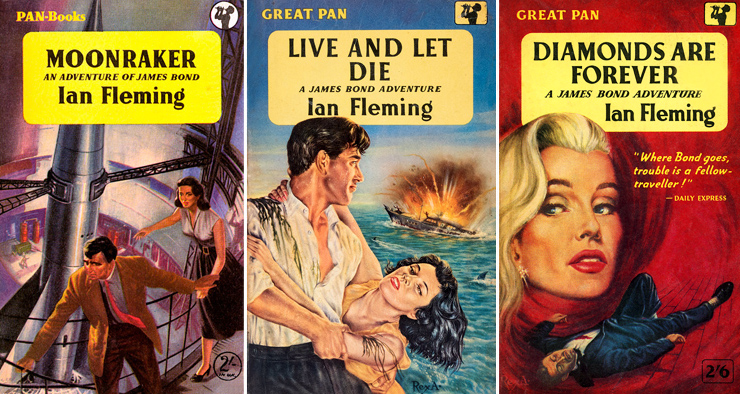 |
|
Unusually MOONRAKER and
not LIVE AND LET DIE was the second James Bond novel published in paperback
by PAN Books in 1956. This decision was taken in order to avoid a
paperback edition of LIVE AND LET DIE competing with the same title which
had recently been released in hardback by
The Reprint Society. The cover artist
for MOONRAKER was Ronald William “Josh”
Kirby (1928-2001) who would later go on to illustrate many of Terry Pratchett's Discworld series
of books from 1983 until his death. The
prolific artist also painted the
UK quad-crown poster for Return of The Jedi
(1983). The initial print-run
of the MOONRAKER paperback was 50,000 copies which had all sold by the
end of 1957. The novel was then out-of-print for a year until the 2nd
printing with a new cover by Sam Peffer was published in 1959.
The first paperback edition of MOONRAKER is therefore one of the hardest
to find nowadays due to its very small print-run. Several titles in the
1969 ‘white-model’ series also had very small print-runs making them
equally scarce, with THE MAN WITH THE GOLDEN GUN limited to just 30,000
copies. |
|
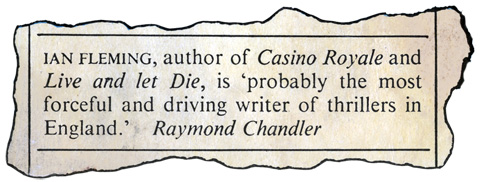 |
 |
|
Rex Archer (1928-1992) became the third artist to paint James Bond for the cover of Ian
Fleming's second novel LIVE AND LET DIE (1954), which was first
published in paperback by PAN Books in October 1957. Archer's cover
for LIVE AND LET DIE is unusual in that it illustrates an actual scene
from the novel and not just a generic representation of the two lead
characters. The square-jawed James Bond is shown in profile as he
rescues Solitaire following their keel-hauling at the end of the
novel. Mr. Big's yacht
The Secatur explodes in the background of the shark-infested
waters. Rex Archer also provided the cover art for DIAMONDS ARE
FOREVER, which followed in February 1958. Although his DIAMONDS
ARE FOREVER cover did not feature the face of James Bond, it sold
significantly more copies on its paperback release than LIVE
AND LET DIE, which had sold out its initial 50,000 print-run and was
not re-issued until August 1958. |
|
|
Rex Archer's DIAMONDS ARE
FOREVER painting appears to be based on a similar cover published in the
USA for the 1957
Perma Books (M-3096) paperback of Widow's Pique by Blair
Treynor, which was the masculine pseudonym of Selina Abraham Treynor
(1888-1967). The original painting was by James Meese (1917-1971) and sold
at auction in the USA for $5,676 in October 2011. Meese had earlier provided the
cover art for the first
American paperback of LIVE AND LET DIE, also published by Perma Books
in June 1956. It was not unusual at this time for different artists’
covers to be repainted and re-used on other editions, but as Widow's
Pique was not published in the UK, it is likely that the cover was
reproduced in one of the imported American periodicals then available,
inspiring Archer
to repaint it for DIAMONDS ARE FOREVER. Later in his career Rex Archer was
a prolific illustrator of children's comics during the 1970s & 1980s.
Although PAN's DIAMONDS ARE FOREVER paperback did not feature Ian
Fleming's hero on the cover, the character would soon be given a face that
would stay with him more-or-less unchanged for the next eight years, in
newsprint at least. |
 |
|
The character of James
Bond became an integral part of British popular culture at a time when Post-War
austerity was coming to an end and the ‘Kitchen Sink/Angry Young Man’
movement was taking the theatrical, cinematic and literary world by storm.
Many of the early films that defined the ‘British New Wave’ were made
by Woodfall
Productions - a company co-founded in 1958 by English director Tony
Richardson (1928-1991), writer John Osborne (1929-1994) and Canadian producer
Harry Saltzman
(1915-1994), who
would later team up with American
Albert R. Broccoli (1909-1996) to make the James Bond films. On July 7, 1958, the
James
Bond comic strip made its debut in the Daily Express, with the
first story CASINO ROYALE introduced by Ian Fleming's friend American
author Raymond Chandler (1888-1959). The
first series of the Daily Express comic strip then ran
uninterrupted for six days every week until February 10, 1962; serialising
all of Ian Fleming's James Bond novels up to THUNDERBALL and three short stories in the same
order as their hardback publication. The Daily Express also printed
abridged versions of DIAMONDS ARE FOREVER, FROM RUSSIA, WITH LOVE and DR.
NO in daily instalments in the weeks before their publication in hardback.
These adaptations were all illustrated by Andrew Robb (1907-1989), and the author's
subsequent novels and two short stories continued to
appear annually finishing with OCTOPUSSY in 1965. |
|
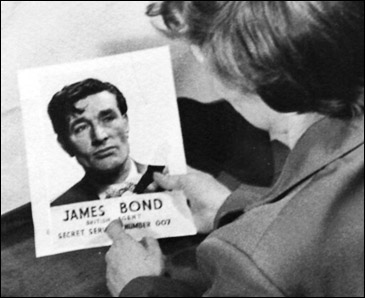 |
|
Photo reference
of Dick Orme used by Sam Peffer for the 1958 PAN paperback cover
of CASINO ROYALE (GREAT PAN G198). |
|
|
In December 1958 PAN
Books re-issued CASINO ROYALE in paperback with a new cover by Samuel
John Peffer (1921-2014), who signed his work and was known to his
friends as ‘Peff’. CASINO ROYALE became the first James Bond novel to be
issued with a new cover, and Sam Peffer would then provide the artwork for
the re-issue of MOONRAKER in 1959, followed by the UK paperback debuts
of FROM RUSSIA, WITH LOVE and DR. NO. For the first time James Bond
was given a consistent face on three of Sam Peffer's
covers.
That face was based on model and actor Dick Orme. Sam Peffer had begun
his career painting front of house displays for West End Cinemas
before moving to Weddell Brothers, who produced film publicity
materials. When their artist was called up for military service in
1940 Peffer replaced him, painting publicity images of Hollywood
film stars. After leaving the Navy in 1946, Peffer became a commercial
artist eventually joining the cinema advertising company Pearl & Dean
in 1953 to become manager of their art department. |
|
|
After going freelance in
the mid-1950s Sam Peffer then began a long and prolific career creating
paperback artwork for many different publishers including PAN Books. When
the painted paperback cover fell out of fashion, he returned to
illustrating video covers and posters for low-budget exploitation films in
the 1970s. One of Sam Peffer's most memorable later
commissions was the artwork used on the
UK quad-crown poster for the
erotic Sci-Fi movie spoof Flesh
Gordon (1974). |
 |
|
Like many artists, Sam
Peffer generally painted his finished artwork based on photographs of
stand-ins and models who posed in identical positions to those conceived
for his rough paintings shown to the publishers' art buyer for approval (which in the
case of PAN Books was Tony Bowen-Davies). Peffer's background
in cinema advertising meant that he frequently used Hollywood stars as the
basis for his rough paintings. Sam Peffer would later paint the likeness
of
Bernard Lee (M in 10 James
Bond films 1962-1979) on the cover of the film tie-edition of Cone of
Silence (GREAT PAN G389); and future Sir James Bond, David Niven, on the cover of Please Don't Eat The Daisies
(GREAT PAN G372) both published in 1960. The new CASINO ROYALE
paperback with the Sam Peffer cover was printed four times between
December 1958 and September 1960, with a total of 115,000 copies
produced. Copies of the two printings with the Roger Hall cover which
had been issued twice in 1955 had sold out in early 1957. 40,000
copies of the new Sam Peffer cover were printed in December 1959, with
18,000 of those being exported. The 22,000 copies sold in the UK now
had the price point of 2/6, which would also explain the need for a
new cover as the two original printings were priced at two-shillings.
The new cover sold out within six months and a reprint of 30,000
units were released in April 1960, and a small proportion of those
exported to Commonwealth countries. |
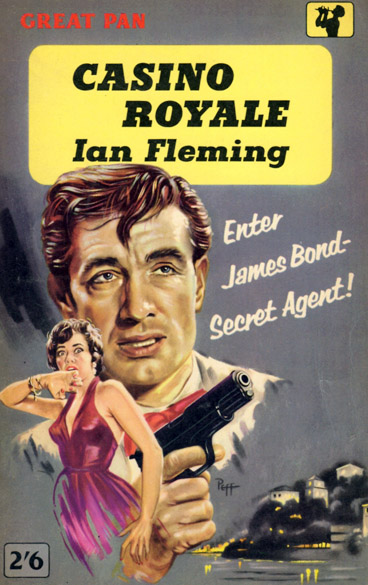 |
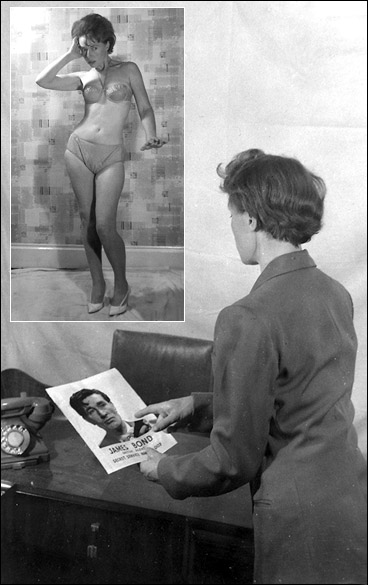 |
|
ABOVE: (left)
Sam Peffer's cover of the PAN Books CASINO
ROYALE paperback issued in December 1958. (right) A reference photograph of model and actor Dick Orme
used as the face of James Bond on the second version of the
PAN paperback of CASINO ROYALE. (inset) Sam Peffer's wife
Kitty provided the photo reference for the figure of Vesper
Lynd. |
|
|
|
With the PAN paperback of
MOONRAKER out of print throughout 1958 a second edition was issued in
February 1959,
with a new cover by Sam Peffer. Following the approval of his rough
painting, Peffer worked from reference photographs of Dick Orme, with his
own
wife Kitty (1922-2020) standing in for Gala Brand. The year-long unavailability of Ian
Fleming's third James Bond novel clearly generated demand in the title,
and the initial print run of 35,000 copies sold out very quickly,
initiating a second printing of a further 25,000 paperbacks in June 1959,
which had also sold out by the end of the year. |
|
|
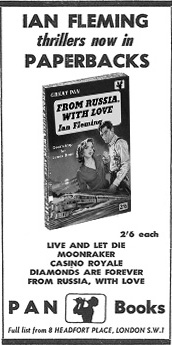 |
With
MOONRAKER back in print again, PAN Books then published the paperback
edition of FROM RUSSIA, WITH LOVE on April 10, 1959, with a striking cover
once again provided by Sam Peffer. The final cover was changed very little
from his original rough painting, with the female model representing
Tatiana Romanova now wearing a tailored jacket (seen on the model in his
reference photographs) instead of the knitted top on the
earlier concept. Sam Peffer accurately replicates the facial expressions
of Dick Orme and the unidentified female stand-in, with Bond's trademark
comma of black hair meticulously recreated. The face of Tatiana is based
on one of the reference photos, whilst the face of Dick Orme as James
Bond comes from another. It is interesting to note that
whilst Sam Peffer and subsequent artists continued to paint James Bond
with the comma of black hair, none depicted him with the thin vertical
facial scar as described by Ian Fleming in CASINO ROYALE. |
 |
|
|
|
 |
|
FROM RUSSIA, WITH LOVE
also proved popular with the initial 50,000 copies selling out very
quickly, and most of the second printing of 40,000 in September 1959
also sold by the end of the year. A third printing of 25,000 copies were
issued to coincide with the February 1960 paperback debut of DR. NO which sported
Sam Peffer's fourth cover painting. Once again working from his initial
rough painting and reference photo of Bond and Honey (whose face is not
seen on the cover), this cover is dominated by a green-hued Doctor No
whose face on the final version is based on Mexican actor Rodolfo
Acosta (1920-1974). |
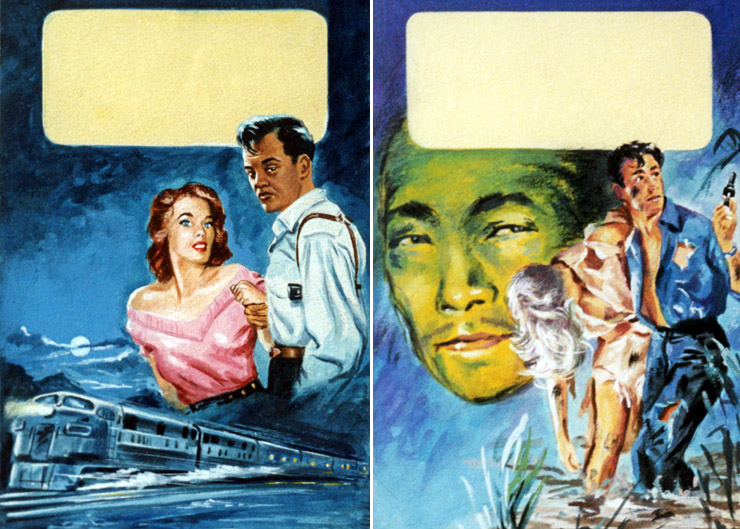 |
|
The face of James Bond on both his rough painting and
final cover of DR. NO appears to be based on Sam Peffer himself. For the
cover for the 1958 PAN paperback The Case
of
the One-Eyed Witness (GREAT PAN G198), Peffer used a photograph of
himself as reference. His
DR. NO rough painting also shows Bond in the same attire but wearing a watch and holding a gun in his
left hand, both of which missing are from the final version. Sam Peffer
would often pose wearing jeans and a shirt, and it is possible that the
DR. NO cover was based on one of many reference photographs of the artist, and repurposed
for the DR.
NO cover. In this instance Peffer's rough painting was also directly based
on one of the reference photographs of him in this attire, and explains why Bond's face is
based on Peffer's own, and not Dick Orme who had featured on the three
previous covers. |
 |
|
Sam Peffer would also use
his wife Kitty and her brother
stuntman Jack Cooper (1923-2010) as the photo reference for his paperback
covers. Cooper also doubled for Robert Shaw (1927-1978)
in the train fight in From Russia With Love (1963); and would later
be seen as one of the gunmen in The Spy Who Loved Me (1977), along
with Richard Kiel (1939-2014) and stuntman/arranger
George Leech
(1921-2012). The trio pursue Roger Moore and Barbara Bach in the Lotus
Esprit (which was filmed in Sardinia) before being forced off the road by
Bond's gadget-laden car. Another model and actor used by Sam Peffer as a
stand-in for photo reference was former Ballet dancer David Davenport
(1921-1995), who would later have his own James Bond connection when he
played [uncredited] the Captain of HMS Tenby in You Only Live Twice
(1967). After his ‘death’ in Hong Kong, James Bond's funeral at sea
was filmed onboard this ship, which was actually moored near Gibraltar at
the time the sequence was shot. |
|
|
|
DR. NO
had the largest print-run to date of any James Bond paperback to date,
with the original 80,000 copies selling out within a few months, and a
second printing of 60,000 issued in August 1960. By the end of 1960 DR. NO
alone had sold 115,000 copies and was not surprisingly the biggest-selling
James Bond title that year. Overall sales of the six James Bond novels published in paperback by
PAN Books continued to rise as each new title was issued, and by the
end of 1960 the number sold in Britain had now reached 836,000. The
four PAN paperbacks with Sam Peffer cover artwork were reprinted again
to meet demand as sales began to increase.
As a freelance artist Peffer only ever painted four James Bond covers
for PAN being paid £45 for each, but he is often incorrectly credited with
many others in the GREAT PAN series. Sam Peffer admitted that he always
signed all covers he painted for PAN and Panther Books, but didn't for
those created for Digit Books as they were paying much less (£10 per
cover) than the £45 he was getting from PAN. To put this into perspective
the average weekly wage for a manual worker around the period Sam Peffer was painting
the James Bond covers was around £13, so £45 was a not inconsiderable sum
for the time. Adjusted for inflation the pre-decimal £45 is now the
equivalent of around £1,000.
|
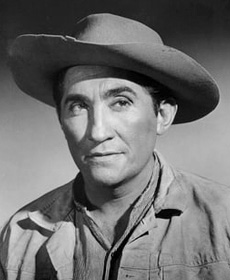 |
|
Rodolfo Acosta
(1920-1974) |
|
|
|
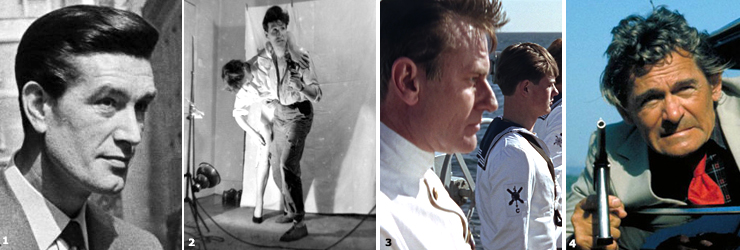 |
|
ABOVE: (1) Fashion model
Richard Orme [photographed in 1958] who was the face of James Bond on
three of Sam Peffer's PAN paperback covers.
(2) Photo
reference used for the DR. NO paperback with Sam Peffer himself as the stand-in for James Bond. (3) Former ballet
dancer turned actor and model David Davenport (1921-1995) was also used as a
photo stand-in for PAN paperback covers and later appeared
[uncredited]
as the Captain of HMS Tenby who oversees James Bond's funeral at
sea at the start of You Only Live Twice (1967). Davenport
also doubled for Sean Connery as James Bond in several scenes
filmed on Ken Adam's massive volcano set at Pinewood Studios. (4) Stuntman
Jack Cooper (1923-2010) as he appeared in The Spy Who Loved Me
(1977). Cooper was the brother of Sam Peffer's wife Kitty and as a
stuntman doubled for Robert Shaw in the train fight in From Russia With Love
(1963), and was also used by Sam Peffer and other artists as a stand-in and photo
reference on other non-Bond paperback covers. |
|
|
|
The Original Face of James Bond CONTINUED |
 |
| |
|
The recent discovery of many of Sam Peffer's
original black & white negatives
shows how slavishly he recreated the final artwork based on the photo
reference. Those used for his four James Bond PAN paperback covers are reproduced here
through the generosity of
TiKiT.net
Acknowledgements: Jon Gilbert & Edward
Milward-Oliver |
|
|




